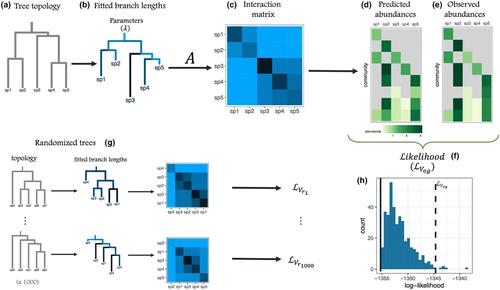当前位置:
X-MOL 学术
›
Ecol. Lett.
›
论文详情
Our official English website, www.x-mol.net, welcomes your
feedback! (Note: you will need to create a separate account there.)
Phylogeny structures species' interactions in experimental ecological communities
Ecology Letters ( IF 7.6 ) Pub Date : 2024-08-17 , DOI: 10.1111/ele.14490 Paula Lemos-Costa 1 , Zachary R Miller 2 , Stefano Allesina 1, 3
Ecology Letters ( IF 7.6 ) Pub Date : 2024-08-17 , DOI: 10.1111/ele.14490 Paula Lemos-Costa 1 , Zachary R Miller 2 , Stefano Allesina 1, 3
Affiliation

|
Species' traits and interactions are products of evolutionary history. Despite the long‐standing hypothesis that closely related species possess similar traits, and thus experience stronger competition, measuring the effect of evolutionary history on the ecology of natural communities remains challenging. We propose a novel framework to test whether phylogeny influences patterns of coexistence and abundance of species assemblages. In our approach, phylogenetic trees are used to parameterize species' interactions, which in turn determine the abundance of species in a given assemblage. We use likelihoods to score models parameterized with a given phylogeny, and contrast them with models built using random trees, allowing us to test whether phylogenetic information helps to predict species' abundances. Our statistical framework reveals that interactions are indeed structured by phylogeny in a large set of experimental plant communities. Our results confirm that evolutionary history can help predict, and potentially manage or conserve, the structure and function of complex ecological communities.
中文翻译:

系统发育构建了实验生态群落中物种的相互作用
物种的特征和相互作用是进化历史的产物。尽管长期以来的假设是密切相关的物种具有相似的特征,因此会经历更激烈的竞争,但衡量进化历史对自然群落生态的影响仍然具有挑战性。我们提出了一个新的框架来测试系统发育是否影响物种组合的共存模式和丰富度。在我们的方法中,系统发育树用于参数化物种的相互作用,进而确定给定组合中物种的丰度。我们使用可能性对给定系统发育参数化的模型进行评分,并将它们与使用随机树构建的模型进行对比,从而使我们能够测试系统发育信息是否有助于预测物种的丰度。我们的统计框架表明,相互作用确实是由大量实验植物群落的系统发育构成的。我们的结果证实,进化历史可以帮助预测,并有可能管理或保护复杂生态群落的结构和功能。
更新日期:2024-08-17
中文翻译:

系统发育构建了实验生态群落中物种的相互作用
物种的特征和相互作用是进化历史的产物。尽管长期以来的假设是密切相关的物种具有相似的特征,因此会经历更激烈的竞争,但衡量进化历史对自然群落生态的影响仍然具有挑战性。我们提出了一个新的框架来测试系统发育是否影响物种组合的共存模式和丰富度。在我们的方法中,系统发育树用于参数化物种的相互作用,进而确定给定组合中物种的丰度。我们使用可能性对给定系统发育参数化的模型进行评分,并将它们与使用随机树构建的模型进行对比,从而使我们能够测试系统发育信息是否有助于预测物种的丰度。我们的统计框架表明,相互作用确实是由大量实验植物群落的系统发育构成的。我们的结果证实,进化历史可以帮助预测,并有可能管理或保护复杂生态群落的结构和功能。






























 京公网安备 11010802027423号
京公网安备 11010802027423号